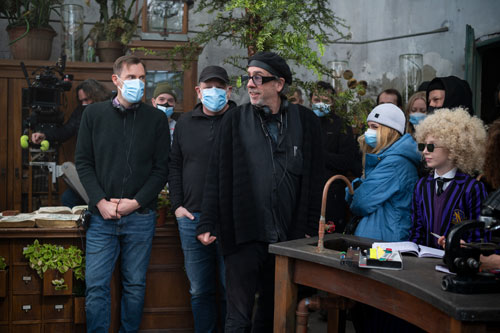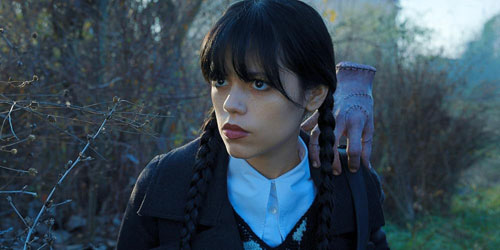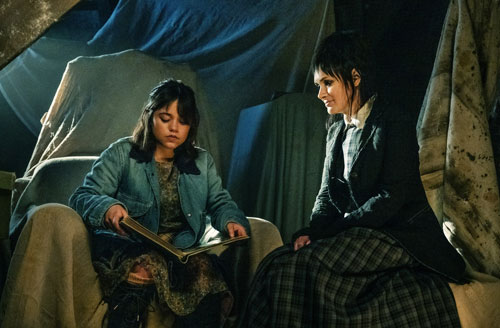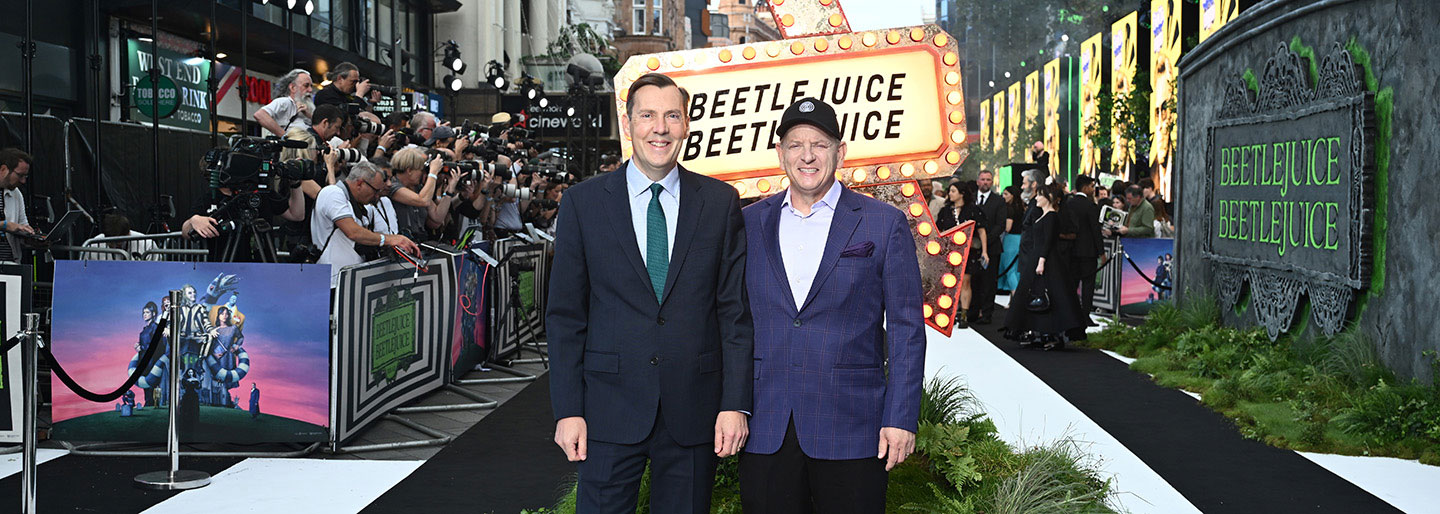When Beetlejuice was first summoned from his attic-bound miniature town 36 years ago, he was a sort of id-driven extension of his creator, Tim Burton, bent not just on causing havoc for the film’s characters, but on disrupting movies themselves—throwing horror, comedy, and family drama in a blender and gleefully smashing the puree button. Long before Deadpool turned superhero movies on their head with 3rd-wall-shattering asides, Beetlejuice writers Michael McDowell, Warren Skaaren and Larry Wilson—along with director Tim Burton—conjured Beetlejuice as a relentlessly meta, wise-acre-ing skeeze—a proto-referential pinball machine that turned horror into a playground for both satire and scares.
So special was this alchemy that, despite multiple stabs at a sequel over the years, Burton never landed on an idea that felt right. Then one day, in the very on-brand locale of Romania, Beetlejuice’s comeback got serious when Burton called screenwriting duo Alfred Gough and Miles Millar into his office after a day of shooting what was about to become their TV series Wednesday.
 Showrunners Miles Millar [L-R], Alfred Gough, and director Tim Burton on the set of Wednesday. Photo by Vlad Cioplea/Netflix.
Showrunners Miles Millar [L-R], Alfred Gough, and director Tim Burton on the set of Wednesday. Photo by Vlad Cioplea/Netflix.“We thought maybe something was wrong,” says Gough. Burton told them that Beetlejuice is the one movie that everyone was always asking for a sequel for. And he thought it was time.
Millar and Gough had already proven to be alchemists on their own. In three decades as WGAW members, their credits included the TV series Smallville and the movie Spiderman 2. Indeed, they were in Romania with Burton because, before they’d ever even met him, they’d created their own new TV series pitch, brilliantly plucking the fan-favorite character Wednesday Addams from The Addams Family franchise and giving her a new life that seemed not only worthwhile, but meant to be.
After writing episode one of Wednesday on spec, they thought of Burton to direct, but doubted he would ever agree. “Everyone told us, ‘He never does TV, blah, blah, blah,’” recalls Gough. They sent the script to Burton’s agent Mike Simpson anyway. “We thought ‘Okay, well, maybe we’ll never hear back, but at least we got it to him.’” he says.
Four days later, “Mike sent us [Burton’s] number and said, ‘FaceTime him,’” says Gough. “From his home near London, with giant dinosaurs looming in the background, Burton said, ‘I love this. I want to do it,’” “We thought, ‘OK, you want to just do the first one?’" He goes, ‘No, I want to do all of them.’”
After Burton had directed a fistful of Gough and Millar’s Wednesday episodes, he summoned them that day in Romania knowing he’d found the writing team he could trust to finally unleash Beetlejuice.
“At one point he said, ‘If I don’t do it now, I’ll never do it,’” says Gough.

The thing we always say about writing is that it's really hard to get to simple.
- Alfred Gough
After seeing firsthand how the duo was able to mix meaningful character development with Gothic horror and satirical humor, Burton (also the film’s producer) was ready to hand over the keys to the Beetlejuice script with no strings attached. “Tim said to us, ‘We’ve been trying to develop this for 30-whatever years. Don’t read anything. I want this to be a fresh start,’” says Millar. “So, it began fresh. It was very liberating for us, and, I think, for him as well.”
Gough and Millar started breaking the script for what would become Beetlejuice Beetlejuice (Screenplay by Alfred Gough & Miles Millar, story by Gough & Millar and Seth Grahame-Smith, characters created by Michael McDowell & Larry Wilson) by focusing on fundamental scripting questions.
 Jenna Ortega in Wednesday. Photo by Netflix.
Jenna Ortega in Wednesday. Photo by Netflix.“We wanted to make sure we were telling the right story,” recalls Gough. “The question was, ‘How do we build a story that honors what Beetlejuice is?’.... Usually there’s a ghost story and there’s always a family drama in the middle of it, and then there’s a satire. We were pretty quickly able to see, OK, if we gave Lydia a daughter and the daughter isn’t like her....That felt like, OK, there’s an obvious conflict.”
They decided that 35-odd years later, Lydia Deetz would be “a kind of damaged person,” says Gough. “She’s been seeing ghosts that entire time,” and hosting a TV show called Ghost House. “She doesn't have a great relationship with her daughter [who] thinks she’s full of shit until [Lydia’s father] Charles’s death brings them back home, and they have to deal with each other under the roof.”
“For us, the family drama has to work regardless of all the ghost stuff,” says Gough. More than simply “being a commercial prospect for a studio, there had to be a reason to be—the movie had to exist for its own good, and not because it’s just a sequel. It had to work for a new audience and have a story that was integral and original to itself. The heart of the whole script was the relationship between Lydia and her daughter Astrid.”
“We came to that pretty quickly because it felt like you needed a character who could bring the audience into the world, who hadn't been there before, and that was Astrid,” explains Gough. “Again, it’s a classic family drama…everybody comes home for a funeral and then all the issues that have been kind of dormant suddenly come to the fore.”
They found a crucial narrative fulcrum in another new character, a local boy named Jeremy, who ultimately leads Astrid to unexpected mortal peril. Lydia is ultimately forced to do the unthinkable: summon “you-know-who” herself to save Astrid’s life.
“The only person who can help her is the last person she would ever want to call,” says Gough. Adds Millar, “That gave us the skeleton of the structure. Those pieces fell into place actually very quickly, which was a relief. If you have a spine that’s strong, then you can slot in the rest of the fun elements, the set pieces and Beetlejuice [himself].”
 “For us, the family drama has to work regardless of all the ghost stuff,” says Alfred Gough of the Beetlejuice Beetlejuice screenplay.
“For us, the family drama has to work regardless of all the ghost stuff,” says Alfred Gough of the Beetlejuice Beetlejuice screenplay.And while the Lydia and Astrid storyline gives Beetlejuice Beetlejuice more emotive punch than its predecessor, Burton, Gough, and Millar in no way forget what made the original film so uncategorizably fun. They revel in the power of sequels with throwback stop-motion set pieces involving a giant sandworm. Gough and Millar wrote in their own fantastic musical set piece to the 1979 Bee Gees hit “Tragedy,” but it’s Burton’s insistence on using the entirety of “MacArthur Park” that gives the sequel an epic answer to the original’s use of Harry Belafonte’s “Banana Boat (Day-O)”—arguably one of that film’s most memorable moments.
Aside from such obvious creative joys, working with Burton was a lesson in storytelling efficiency. “He shoots very classically. There is, like, no coverage. He shoots with one camera. He describes it as graphic. He’s just very masterful,” explains Gough. “The thing we always say about writing is that it’s really hard to get to simple. That’s what you’re always trying to do. And he’s very good at doing that.”
“Beetlejuice Beetlejuice is incredibly singular stuff….it was nice that he was able to be the air traffic controller for all the ideas,” continues Gough. “Because again, he had to go make the movie, so he wasn't going to put anything in the movie that he didn't want to do. I think that's the other thing with Tim—he makes the movie because he loves it, and everyone else is invited. There’s no cynicism. He made this movie because he wanted to, and he loved it, and that really comes through.”






